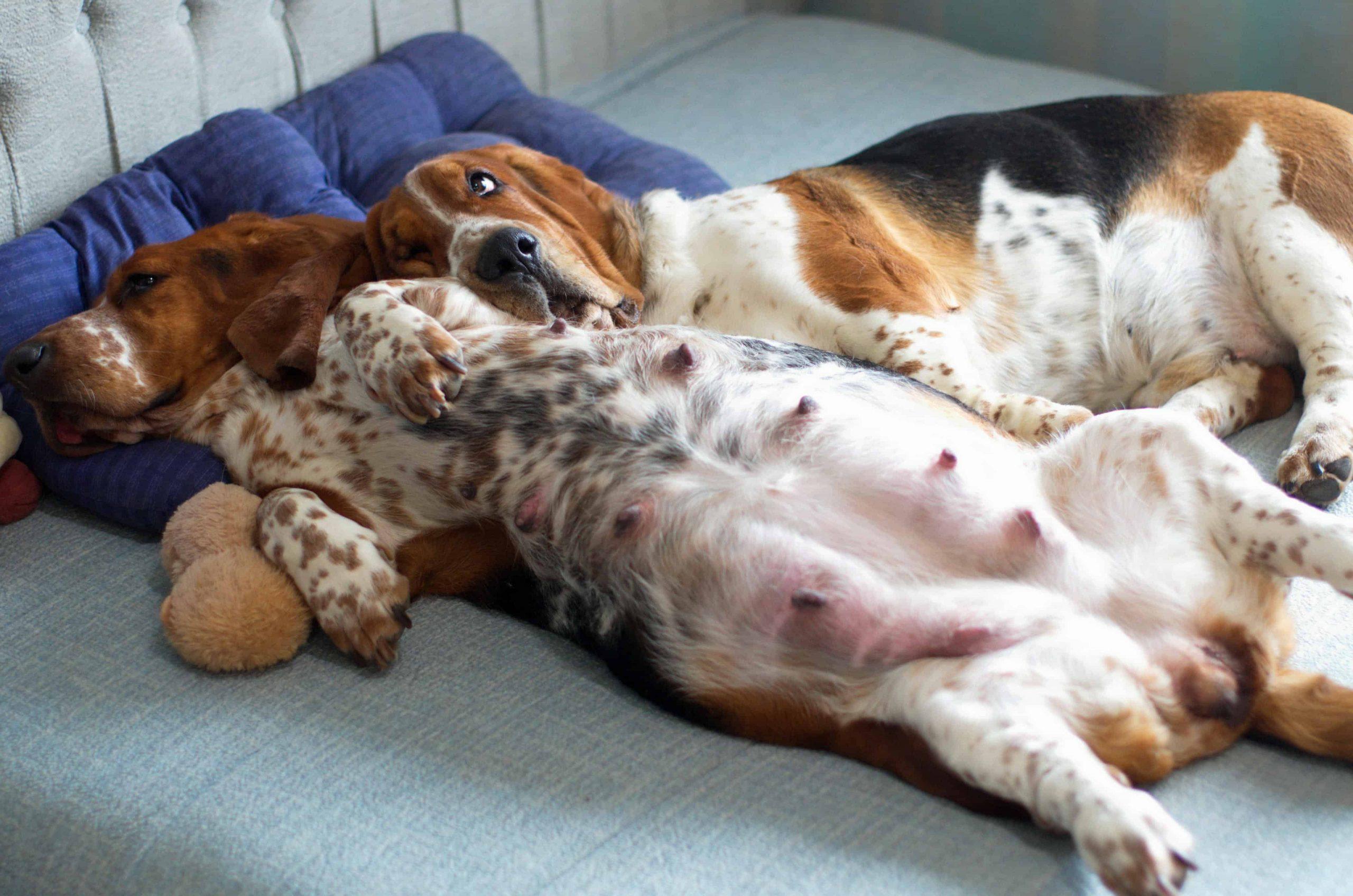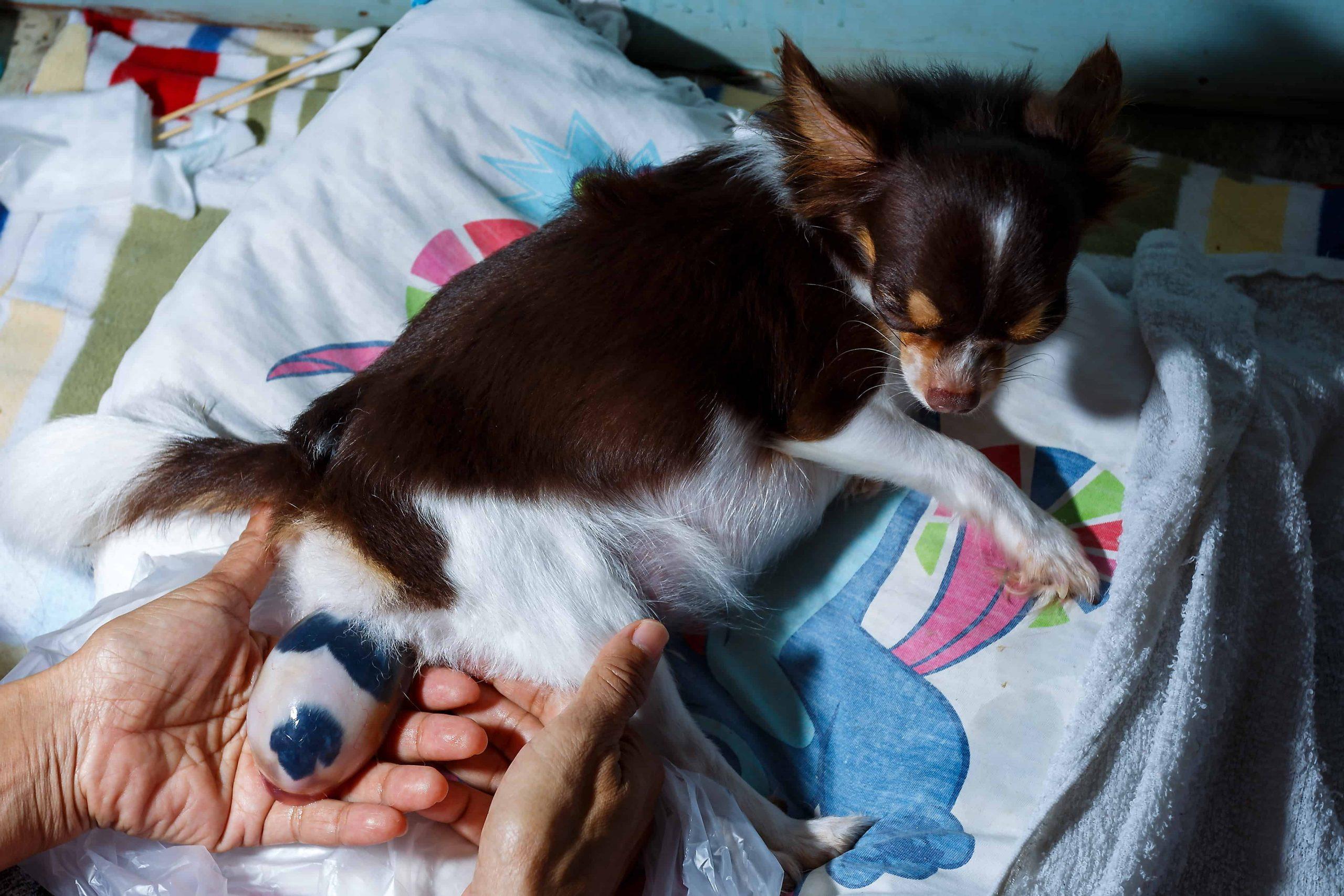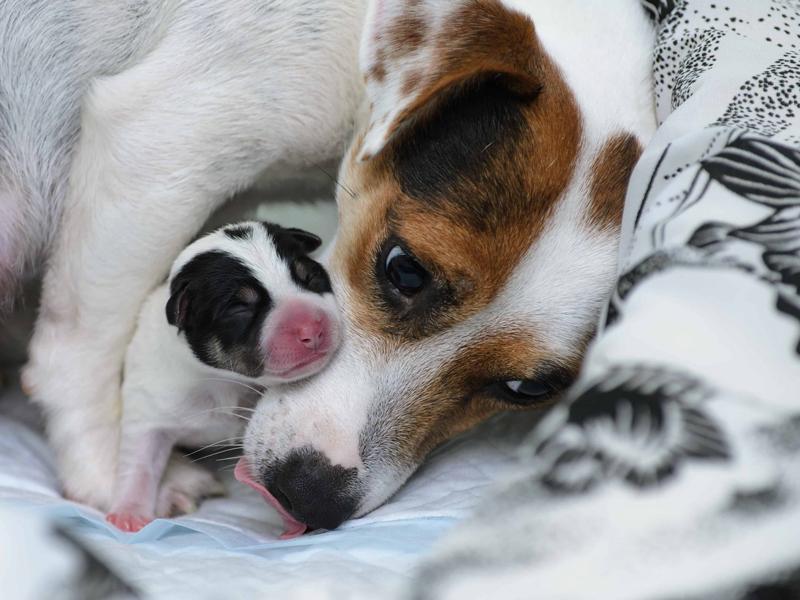Soon your home will be overrun by a litter of puppies that could melt even the hardest of hearts.
What to do if your dog is pregnant? Her behavior might be particularly challenging to handle as her hormones spiral out of control.
And the next few months may be daunting for you too, especially if this is a new experience.
But take comfort in the fact that many canines have healthy pregnancies and don’t require much intervention during the delivery stage.
Having said this, there’s still a lot you can do to support your beloved pooch and her pups through this journey. At any rate, it helps to be prepared in case anything goes wrong.
Let’s talk about what to expect when your doggie is expecting (whether planned or accidental).
Stages of dog pregnancy
Canine pregnancies generally last for around 63 days, which is just over two months (nine weeks).
However, don’t hold us to this. The timeframe isn’t set in stone – it fluctuates depending on the breed of your pooch and how many pups she’s carrying.
There are three trimesters, spanning around 21 days each.
It’s a fairly safe bet that by the end of gestation, there will be 1 to 12 puppies running around (5 or 6 is the average litter size for all breeds).
Before we talk about what to do when your dog is pregnant for the first time, here’s a brief overview of the different stages of dog pregnancy.
This will give you an idea of what to expect. After this section, we will explore some crucial points in more detail further down.
Week 1: Fertilisation occurs within a few days of mating when in heat. There may be signs of morning sickness, but other than that, you’re pretty much in the dark about the pregnancy.
Week 2: The puppies start to develop from fertilised eggs.
Week 3: The puppy fetuses are now clinging to the wall of the uterus, and this is how they will be nourished during gestation. Your dog may have a bigger appetite, and act a little differently than usual.
Week 4: This is the week you may receive confirmation from your vet that your dam (canine mother) is pregnant. An ultrasound can be conducted from around day 25. Not only does this confirm pregnancy, it also reveals the number of pups and any health problems. Your vet will let you know if your pooch needs any dietary supplements, and will probably suggest that vigorous activity is replaced with moderate movement.
Week 5: Your dog’s weight gain will be more obvious now. By this stage, she should eat a nourishing diet that’s specifically for pregnancy – especially as the fetuses start developing organs. But don’t go overboard by feeding too much! Another ultrasound can reveal the sex of the puppies.
Week 6: The fetuses are growing fast. Your dam’s waist will actually start to look trimmer as the puppies prepare to enter the world by shifting into the birth canal. She may be hungrier, but don’t let her eat too much as large quantities of food will cause discomfort.
Week 7: Now the skeletons are becoming more solid for each fetus, and their coat starts to develop. It’s time to make an appointment to get your canine wormed at the vet, so that her puppies are less likely to get parasites. You might notice that your dog is leaking colostrum (first milk) from her nipples. It’s a good idea to set up a cosy and peaceful environment for the delivery (called whelping).
Week 8: Nearly there! You may actually notice the pups moving inside your dam when she’s lying down. Nesting behaviour is common at this stage: tearing blankets, grooming excessively, rearranging furniture and digging around.
Week 9: Expect that your pooch will be rather restless and exhausted by now, and she may isolate herself in the whelping area. Now is the time to take her temperature a few times a day. When her temperature drops to 36 degrees Celsius (from 37 or 38), you know the puppies will be earth-side within the next two days.
Delivery (whelping): In most healthy pregnancy cases, there’s not much that you need to do here. In fact, if you try too hard you might get in the way. Keep a watchful eye on your dog by checking in every 15 minutes. Please call your vet if you have any worries.
Phew! Ok, now that we’ve covered that, What to do if your dog is pregnant?

Step one: visit your vet
You’ve noticed the general signs of canine pregnancy, so why do you need to go to the vet to confirm what you suspect?
First, sometimes these symptoms are deceiving. Your dog might not be expecting. It’s possible she’s gaining weight or acting differently due to illness.
There’s also a chance that your dam is experiencing a phantom (fake) pregnancy – which shares many symptoms with gestation – but without the actual pups!
Only a vet can rule out these possibilities and confirm the pregnancy.
To diagnose the pregnancy, your vet will go over your pooch’s history and feel her stomach region. Pregnancy can also be detected via a hormonal test, ultrasound or X-ray. Please note, you should never attempt to feel around for the pups yourself, as only an experienced vet can safely do this without causing trauma or injury.
Beyond confirming the pregnancy, there’s another reason to book an appointment at the signs of gestation:
Your vet will arm you with the tools and knowledge needed to best support your dog through her short gestation period. You will learn what diet provides the highest nourishment, how much exercise is appropriate and how to create a nurturing environment. When the time is right, your vet will also advise you on a suitable worming treatment.
Finally, is your dog at risk of having a complicated pregnancy or difficult delivery (canine dystocia)? Your vet gives you all the information that you need to be prepared. For example, you’ll find out what’s involved with canine caesarean sections – should it come to that.
We suggest visiting your veterinarian when you first suspect a pregnancy and whenever you have concerns.
On top of that, you may wish to get more diagnostic information as gestation progresses:
- Week 4 (after day 25): an ultrasound can confirm the pregnancy and number of pups
- Week 5: to find out the sex of the puppies

Looking after your dog during her pregnancy
Optimal nourishment:
There’s a fine balance between feeding your dog too little and too much during gestation. Make sure she’s getting all the nutrients she needs, without overloading her already-stretched system.
During the first month, there will be a change in appetite. Many dams will eat less food, due to nausea and vomiting. However, some dogs may be hungrier than usual. A high quality food brand is best, but stick to the same amounts.
After the first month, you can gradually add more food to the bowl. The emphasis is now on foods that contain plenty of fat and proteins. Just like humans, dogs can take pre-natal vitamins and folic acid! This is usually recommended for first-timers, to lower the risk of complications during gestation and nursing. Don’t worry about the specifics of how much and what to give, your vet will advise you based on your dam’s breed and health history.
Gentle exercise:
If your pooch normally enjoys a long stroll or playing catch, it’s fine to stick to this routine until her belly starts to become larger in the final 21 days of gestation. She can still exercise after this point, but gentle movement only (such as a short walk). Right now she needs to preserve her energy for nourishing the pups, and probably won’t feel like running around anyway!
Worming:
You should be worming your dog regularly, but this is particularly important during pregnancy. If mum has parasites, she will pass these onto her pups. Not what you want! Apply worming treatment to your pooch, in order to give her babies the best start to life. This is normally done at week seven, but please ask your vet when the most suitable time is, and what product is safe to use during gestation. On a similar note, make sure that Fluffy has had her required vaccinations too.
Set up a comfortable nesting space for whelping (labor):
Create a quiet and warm whelping environment that your dog feels comfortable to give birth in, at least a few weeks before the due date. Fill this space with blankets, linen or towels – and make sure you have enough on hand to keep the area completely dry. If you line the box with thick newspapers, this will provide extra insulation. Your pooch will need time to get used to the space as her own little sanctuary, so encourage her to explore it during pregnancy.
This area doesn’t need to be fancy. A quiet space in a suitable corner of the house will work fine. You can even buy or easily build a whelping box to provide a sense of privacy and safety. If you have other pets, don’t allow them into this area. This article provides some ideas on setting up the ideal whelping box.
One word of advice:
Don’t choose a space that you can’t easily clean, as the floor could get messy during whelping.
Also, consider safe heating options that won’t burn the pups.
As the delivery day draws closer, the room temperature should be slightly toasty at around 24 to 26 degrees, to keep the puppies warm in their first week of life (when their bodies can’t yet regulate).
Finally:
It’s not a good idea to dismantle this room immediately after birth. Let the whelping room or area remain for a few weeks or so, to give mum and pups time to bond in peace.

Delivery (whelping)
Your vet will let you know if your dog is at high risk of birthing complications. If this is the case, a caesarean section or induction of labor can be arranged.
In most cases, home delivery goes smoothly. There isn’t much that you can do here, so let nature run its course. Don’t completely abandon your pooch to her own devices though, regularly monitor her to make sure that everything is ok.
After the initial labor signs, expect the first pup’s arrival within an hour. If your dog is having a lot of contractions, but there’s no puppy after 45 minutes, call your vet. Your vet may prescribe oxytocin, which you can give your dog if her contractions are weak (but this should only be administered as a last resort).
It helps to have a whelping kit on hand too, in case you need to intervene. For example, you may need sterile gloves to tear open the foetal sac, if a puppy is entangled in it. In the lead-up to the delivery, it’s important to ask your vet what you should do if there are birthing complications, so that you’re prepared.
Something worth repeating:
During the whelping, please don’t hesitate to call your vet if you have any concerns (even if you think you’re overreacting).
In a future post, we’ll discuss how to best care for a litter of puppies after they’ve arrived, so stay tuned.

Potiki dog insurance for veterinary check-ups
You may need to visit your vet a few times during gestation. These consultation fees add up! There’s also the possibility of induced labor or C-section, which costs thousands of dollars.
If you have reliable pet insurance, you don’t have to worry about budgeting to pay for vet fees. Your policy would cover most of the costs, as long as it’s not a pre-existing condition.
Potiki’s affordable pet insurance gives you that peace of mind, but we go one step further…
We also send you FREE Potiki Perks to help you take care of your best pal’s general wellbeing.
All customers get access to Potiki Perks#. Potiki Perks# comes with the free Potiki Perks app offering exclusive offers, 2-for-1 deals, and up to 20% off in categories like dining, activities, shopping, travel, and more. You will also have access to myPetPass™** which unlocks extra support and savings on everyday pet essentials such as online vet care, discounted pet prescription medication and savings on premium pet food.
This chat service will come in handy during your dog’s pregnancy, especially if you have questions about your role during the delivery process!
Remember, these bonuses are on top of reliable Potiki pet cover (via petinsurance.com.au). We pay for 80 per cent of your eligible vet bills for unexpected illness and injury.
- Get a quick Potiki quote to find out what your premium will cost for one year.
- Submit payment if you’re satisfied with that amount (email us on [email protected] with any questions).
- Log into your personal portal to select items for your Potiki Perks package, which will be swiftly delivered to you.
- Lodge a claim if you need help paying vet bills for unexpected sickness or injury.


